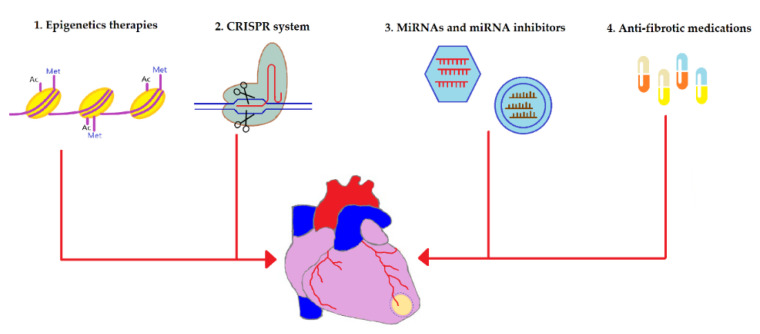Figure 2.
An overview of the novel strategies utilized to alleviate fibrotic remodeling after cardiac diseases. Multiple cardiac pathologies tend to terminate in the replacement of contractile myocardium with the fibrous tissue, one of these diseases is myocardium infarction (infarction area is depicted in yellow). Novel anti-fibrotic therapies target various levels of the pathogenesis of cardiac fibrosis: (1) Epigenetics-based therapies such as histone deacetylase (HDAC) and histone methyltransferases (HMT) have been shown to regulate the gene expression of many fibrosis-associated proteins such as TGF-β1, collagen type I, collagen type III, fibronectin, and many others. Consequently, HDAC inhibitors and HMT inhibitors have been applied to suppress the expressions of those proteins and downregulate fibrosis. (2) Clustered regularly interspaced short palindromic repeats (CRISPR) technology has been used to silence pro-fibrotic genes as well as to introduce “useful” genes into stem cells to enhance their therapeutic potential for myocardial fibrosis. (3) Anti-fibrotic microRNAs (miRNAs) can be utilized to repress the gene expression of fibrosis-mediating genes at the level of mRNA whereas miRNA inhibitors interact with pro-fibrotic miRNA and inhibit them. Viral vectors (shown as hexagons) are generally used to deliver miRNAs while miRNA inhibitors can be transferred using liposomes (depicted as circles). (4) Anti-fibrotic medications such as pirfenidone, angiotensin receptor blockers, and NLRP3 inflammasome inhibitors work by inhibiting enzymes and signaling molecules involved in the pathophysiology of cardiac fibrosis.

